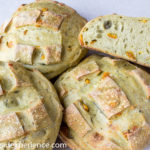Description
This naturally leavened Green Tea and Orange Loaf, infused with matcha green tea powder, candied orange peel and orange blossom water, has a beautiful green color before baking and a lighter green after baking.
Ingredients
Levain
- 50 grams all-purpose flour
- 50 grams water
- 25 grams sourdough starter (I used 100% hydration starter)
Final Dough
- 500 grams all-purpose flour, plus more for dusting
- 250 – 300 grams water, divided 125, 125, 50
- 10 grams salt + 15-20 grams water
- 30 grams olive oil
- 25 grams orange flower water
- 10 grams (2 tsp) matcha tea powder
- 150 grams candied orange peel, chopped or finely diced (I liked the bigger pieces myself)
Instructions
Levain
- In the evening of the day before making the bread: Place the starter, flour and water in a small bowl. Mix with a wooden spoon until the flour is stirred in well.
- Cover the bowl with a plate, or bees wrap, and let it rest overnight in a warm place.
Final Dough
- Pour 125 grams water, orange blossom water and olive oil over the levain. Mix completely to break up the levain.
- In a large bowl, add the flour. Pour the levain/water mixture over the flour and mix to incorporate. Add the rest of the water, gradually, and as needed to fully hydrate the dough. I added 100g, then 30g, and then another 30g water as I was mixing the dough.
- Cover, and let the dough rest for 20-30 minutes, then sprinkle the salt over the top and dissolve it with 15-20 grams of warm water.
- Cover, let rest for 30 minutes, then fold in the matcha tea powder and candied orange peel and knead the dough until it becomes evenly colored, smooth, and elastic. Add more water if the dough starts to tear.
- Note: My dough was sticky after adding the candied orange peel. It was almost too dry up until that point. After the stretch and folds, it was fine.
- Shape into a ball, cover, proof for 2 hours. Stretch and fold the dough after 1st hour. Let rest for final hour. It should increase in volume by the end of the final proof.
- Remove the dough to a lightly dusted work surface. Divide the dough into 4 equal pieces, about 260 grams each. Shape into balls, cover with a dish towel and let rest for 15 minutes.
- Roll the dough pieces between your hands to create tension, and form smooth and well-rounded boules.
- Place the loaves, seam-side down on a parchment-lined baking sheet. Cover with a damp cloth and let proof for 1 hour 15 minutes.
- Preheat the oven to 450 degrees F. with a baking stone on the bottom shelf (or the next shelf up depending on how many shelves your oven has. Mine has 5 shelves.) and place an overturned roasting pan on top. If you don’t have a roasting pan, you can use a stainless steel mixing bowl.
- Score the loaves in a crosshatch pattern (or the pattern of your choice).
- Transfer the loaves on the parchment to the preheated oven. Remove the baking sheet. Then place the roasting pan on top. Bake for 18 minutes. Don’t burn them.
- Remove from the oven and leave to cool on a wire rack.
Notes
Adapted from The Larousse Book of Bread by Eric Kayser
There are two ways to incorporate the sourdough starter in this bread.
1) Feed your sourdough starter the evening before you plan to bake, let it rest overnight at warm room temperature, then use 100 grams of the fed sourdough in your loaf.
2) Create a levain. This is the method outlined in this post.
- Category: Sourdough Sweet Bread
